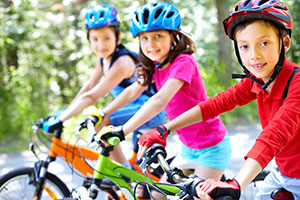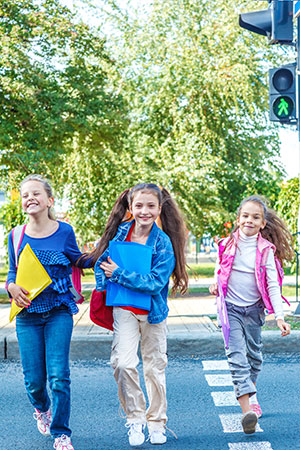
Adults often think children are able to handle traffic safety by themselves before they are actually ready. Children don’t have the skills to handle these risky situations until at least age ten, some even later. For children, the bicycle is their first vehicle; it is a source of pride and their mode of transportation. The attitudes instilled in children now will determine how he or she will ride their bicycle, navigate through traffic on foot and even influence their driving behaviors as an adult.
Facts
- Boys are much more likely than girls to be injured or killed in traffic.
- Bicycles are vehicles. Children should not ride bicycles in the road until they fully understand traffic rules and show they can follow them.
- Young children are not small adults!
- Children often act before thinking and may not do what adults or drivers expect.
- Children assume that if they see the car or driver, the driver sees them.
- Children have a field of vision one-third narrower than adults have.
- Children cannot judge speed or distance.
- Children think cars can stop instantly.
- Children take longer to locate where a sound is coming from, this means they may not respond quickly to horns or sirens.
Bicycle Helmets
- Head injuries are the most serious type of injury and most common cause of death or permanent injury for bicyclists.
- Bicycle helmets can reduce the risk of serious head injuries resulting in a crash by 85-88% if worn and fitted properly.
- You should always wear a helmet regardless of slow you are riding, a fall at any speed can cause severe head injury.
- Be sure that your helmet fits well, is adjusted to your head and covers your forehead.
- Be sure the chin strap is tight enough to keep helmet from slipping forward, backward or side to side, but loose enough to slip a finger under it. Adjust the 2 side straps so they meet in 1-2 finger widths above your eyebrows and be level front to back and side to side. If you wear your helmet too far back it won’t protect your forehead which usually hits the ground first in a spill.
- Buy a helmet that fits the child now, not a helmet to “grow into.”
- Replace any helmets that have been involved in a crash!
- Insist children wear a bicycle helmet every time they ride and set a good example by wearing your helmet.
Child Pedestrians

- When walking with children, talk to them about street safety. Show them how to stop at the edge of the street and look for cars. Don’t expect younger children to do this alone.
- Teach young children to cross with an adult.
- Teach them to cross at signalized intersections when possible.
- Teach them to use a crosswalk when crossing near a corner, and to watch for turning vehicles.
- Teach them to stop at the curb, edge of roadway, edge of parked cars or corner before proceeding. Look LEFT, RIGHT, LEFT, and OVER THEIR SHOULDER for traffic. Left traffic pass then look again before crossing, and continue to look in both directions while crossing.
- If you see a steady DON’T WALK signal, stop. Wait until the WALK signal is present before beginning to cross the street.
- A flashing DON’T WALK signal indicates you shouldn’t start to cross the street, However, if you are in the middle of the street and the DON’T WALK signal begins flashing continue walking. You have time to cross the street.
- When crossing intersections with traffic lights and pedestrian signals, it is important to follow the signals carefully.
- The WALK signal indicates that it's your turn to cross the street, but they do NOT mean it is safe to cross. The WALK signal means LOOK, then if it is safe, begin to cross the street.
Additional Resources
Bicycle Safer Journey
Pedestrian Safer Journey
NHTSA Bicycle Safety
NHTSA Pedestrian Safety
